Cuomo Extends School Closure, Names New Hospital Sites
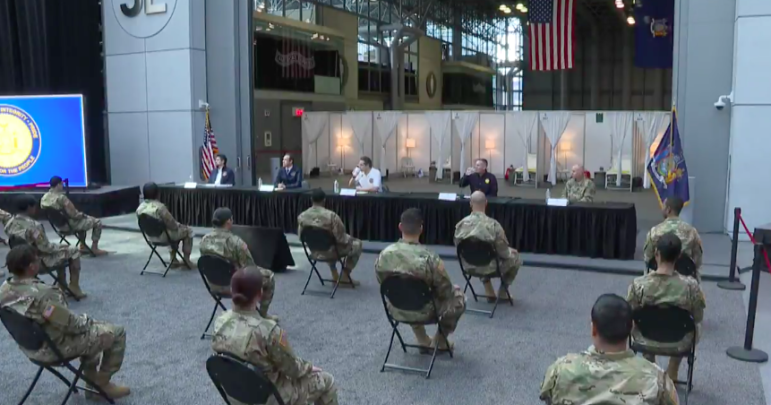
Friday, March 27, 2020, 2:15 p.m.
Governor Cuomo on Friday extended the closure of schools, ordered all non-essential construction projects halted and announced new plans to expand hospital capacity throughout the state, where the death toll overnight leaped 35 percent in the past day to 519—a number the governor said was certain to grow.
Currently, the state has 44,635 known cases of coronavirus. About one in five have required hospitalization. As of Friday morning, 6,481 remained in hospital—1,583 of them in intensive care. Just over 2,000 people with coronavirus have been treated and released from hospitals.

CUNY
The College of Staten IslandEven as the hospitalization numbers climb, the rate of increase has ebbed: Last week the counts were on pace to double every two days, but now they are on track to double every four days. That trend buoys hope that New York’s hospital capacity will expand in time to absorb the peak caseload, which Cuomo on Friday said was expected within three weeks.
The state has already ordered hospitals to expand capacity by 50 percent and encouraged them to aim for 100 percent increases, created four overflow hospitals, begun to convert CUNY dorms to be used for hospital care and learned that a U.S. Navy hospital ship with room for 1,000 patients is en route. Those measures, however, still leaves the state well short of the 140,000 beds Cuomo thinks they might need.
To close the gap, Cuomo announced plans to build overflow hospitals at the New York Expo Center in the Bronx, Aqueduct Racetrack in Queens, the Brooklyn Cruise Terminal and the College of Staten Island.
New York City’s case count grew overnight by more than 1,000 to 25,573, but according to data released by the city health department, the death toll rose by just one case to 366. The city released a map breaking down infection rates amount the tested population by neighborhood.
Cuomo, whose previous order had closed the schools statewide through April 1, extended the closure until April 15. Mayor de Blasio has closed New York City public schools through April 19.

Jarrett Murphy
Jail Population Hits Milestone as Releases Slowly Mount
Thursday, March 26, 2020, 6:12 p.m.
New York City’s jail population slipped below 5,000 for the first time in more than seven decades on Thursday after the de Blasio administration released additional inmates to protect them from the coronavirus.
De Blasio, whose team had earlier released 75 inmates and on Wednesday said he would release another 200 city-sentenced inmates on his own authority, told reporters on Thursday evening that a total of 200 inmates had now been moved out of city jails. “We have an obligation to think of them the same way we’re thinking of other New Yorkers in those high-risk categories,” he said.
The mayor did not specifically discuss two other groups of medically vulnerable inmates—100 held on bail whose released would require the consent of the district attorney who oversaw their case and 700 detained on technical parole violations—whose fate is controlled by the state, whom he had earlier indicate he was reviewing in the hope of securing additional releases. He did, however, say that “going into tonight that number of inmates released will go from 200 up to 375 and we will keep giving you updates as we go along.”
The releases so far, probably abetted by a fall-off in arrests and a move by at least some of the city’s district attorneys to avoid requesting bail during the crisis, had brought the jail population to 4,906 on Thursday morning.
Advocates have been pushing for larger numbers of releases than the mayor has said he is contemplating.
Asked about whether a parallel process might occur for children in the city’s youth detention system, de Blasio said a plan would come soon. Earlier on Thursday, the Legal Aid Society said it had filed suit to gain the release of 10 kids in that system. “By physical design, these facilities house youth in close congregate settings, with shared dining rooms, common recreational areas, communal bathrooms and showers, and, at some sites, shared bedrooms,” the organization said in a statement. “In light of the extraordinarily dangerous nature of the COVID-19 pandemic, with its extremely high degree of contagion and its transmission rate in New York City growing at an alarming pace, these youth are extremely vulnerable to infection by the virus and to its potentially devastating consequences.”
CUNY Suspends Online Learning at Most Campuses for Several Days
Wednesday, March 25, 1:50 p.m.
Less than week after resuming classes online, the City University of New York announced a six-day pause beginning later this week. What CUNY is calling a “recalibration period” will begin this Friday, March 27, and run through Wednesday, April 1.
In a letter to CUNY students and faculty, Chancellor Félix Matos Rodríguez wrote, “The nationwide move to distance education necessitated by the coronavirus crisis has served to spotlight disparities that stratify the higher education landscape. In the days since CUNY re-opened classes under distance learning instruction, these matters of equity and access have already begun to surface on our campuses.”
CUNY cancelled classes for a week after the COVID-19 crisis struck to give teachers and students a chance to prepare for online learning, which began on March 19. But the governor’s PAUSE executive order last week effective ended all work on campuses and closed off access to computer labs that some students without home access had been coming in to use in order to keep up with classes.
This second time-out “will allow our colleges to continue their efforts to provide their students with access to the equipment they need to complete their semester requirements under these uncommon and unforeseen circumstances,” the chancellor said. “We are making this move before we get deeper into the semester, to ensure that we are upholding the University’s mission and giving each and every CUNY student an opportunity to thrive.”
Several CUNY facilities are exempt from the order and from a related move to shorten Spring Break.
MTA Reduces Service Amid Plunging Transit Ridership, Wait for Relief Funding
Wednesday, March 25, 12:30 p.m.
The MTA will begin reducing transit service following a massive drop in ridership and revenue in recent weeks as more New Yorkers stay home during the coronavirus emergency.
Starting Wednesday, subways — which are now experiencing an 87 percent decline in ridership compared to this time last year — will run with some reductions, including local service on some express lines and branches, officials said. The B, W and Z train lines will no longer run on weekdays, but will be covered by other local service. Service during morning and evening peak hours will stay the same.
The MTA will begin running fewer buses starting Thursday, with the system operating at 75 percent of normal service, which officials will help reduce crowding at bus depots. Similar reductions are planned for the city’s commuter rails: the Long Island Rail Road will run more than 200 fewer trains on weekdays starting Friday, while MetroNorth will reduce its weekday capacity by 50 percent.
Officials say the changes, dubbed the “MTA Essential Service Plan,” will continue to offer enough buses and trains to move the city’s emergency responders and essential workers, with adequate space to spread out. Transit will be monitoring ridership levels and the plan will be adjusted if needed, officials said.
“Reducing service is not ideal, but it’s the right thing to do right now,” said MTA Chairman Pat Foye during the agency’s monthly board meeting Wednesday. “This is an extraordinary time calling or extraordinary measures.”
The agency has made other changes this week in response to the ongoing crisis. Local and Select Bus Service routes are requiring riders to board buses from the rear, while MetroCard purchases now must be made at machines instead of subway station agent booths (except for reduced-fare cash transactions) in an effort to better protect workers. At least 52 MTA employees have tested positive for COVID-19 so far, officials said Tuesday night.
Meanwhile, the MTA has been asking for federal relief funding to help it withstand the financial consequences of the pandemic. On Wednesday, lawmakers in Washington announced they’d struck a deal to pass a $2 trillion coronavirus relief package, including $25 billion in emergency transit funding — $4 billion of which is slated for the MTA, Foye said Wednesday.
“That’s of course subject to the president signing the bill,” he said, adding that the MTA will likely need more funding in the future.
“The full impact of this pandemic is still unknown,” he said. “We’ve planned for disruptions in the past, but never on this scale and scope. We need $4 billion, but we’re only at the starting point of this crisis. We will need substantially more than that to survive.”
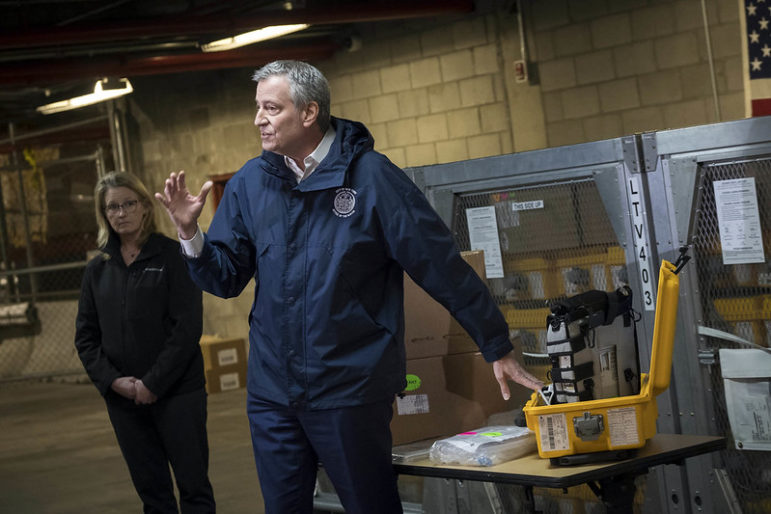
Ed Reed/Mayoral Photography Office.
Mayor Bill de Blasio visits the New York City Emergency Management Warehouse, where 400 ventilators have arrived and will be distributed. NYCEM Warehouse, Brooklyn.Mayor Planning 300 Releases from Rikers
Tuesday, March 24, 5:10 p.m.
Mayor de Blasio said on Tuesday the city would move to release an additional 300 inmates from Rikers Island and other city jails, bringing to 375 the number of people released from detention amid the coronavirus crisis.
The 300 defendants are serving city sentences of less than one year for misdemeanors and non-violent felonies, and represent the only prisoners that de Blasio can release on his own authority. The city is reviewing another 100 cases of medically vulnerable people who are awaiting trial and held on bail, whose release would require sign-off from the district attorney who oversaw each case, and 700 people who are being held for technical parole violations and whose cases are controlled by the state.
“We have to work through some intense, complicated legal issues,” de Blasio said. Referring to the risk to people over 70 or those suffering from a list of chronic health conditions, the mayor said, “Those in immediate danger, I strongly believe they all should be released.” However, he said he had decided not to release people serving time for domestic violence or sexual offenses.
The Board of Correction, an independent monitor of the city’s detention system, has called for releasing larger numbers of detainees and inmates than de Blasio has identified.
De Blasio rejected predictions by President Trump and others that emergency measures might be scaled back relatively soon. “April will definitely be worse than March,” he said. And May could be worse than April. “The notion that we could be back to normal in April is absolutely inconceivable.”
He hailed the arrival of 400 ventilators and the promise of another 2,000 from the federal government but said more would still be needed for patients who are in respiratory distress. “It is a plain as this: If a doctor cannot get a ventilator to that patient literally when they need it and if too many minutes pass that patient will suffocate. They will die a terrible death and be gone forever.”
The mayor said he would determine on Saturday whether New Yorkers are heeding directives banning group play at parks and playgrounds. If, during the warm days forecast for the rest of the week, official observe New Yorkers failing to comply with those mandates, “We will be prepared to shutdowns playground for the foreseeable future,” de Blasio said.
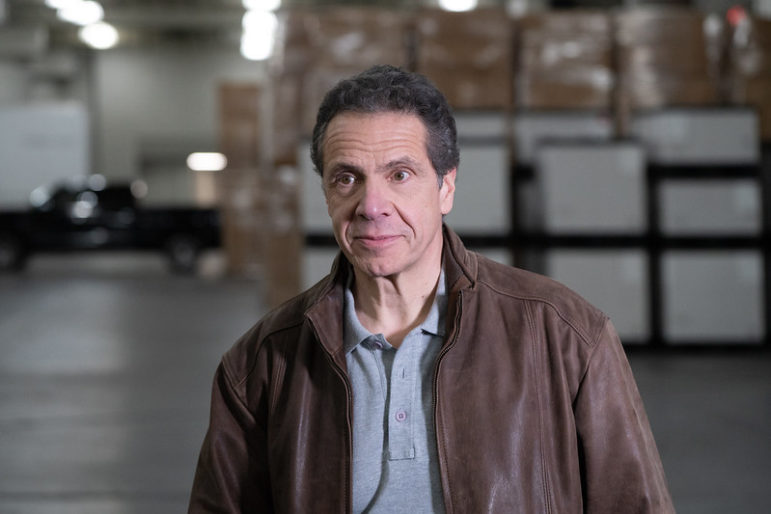
Office of the Governor
Governor Andrew M. Cuomo tours construction of temporary FEMA hospital at Jacob K. Javits Convention Center.Cuomo Says Virus is Accelerating
Tuesday, March 24, 12:28 p.m.
Gov. Cuomo on Tuesday said a steeper and faster curve of Coronavirus illnesses than expected now confronts New York State, and that the state would need 140,000 hospital beds, not the 110,000 he had earlier predicted.
“We’re not slowing it. And it is accelerating on its own. We were looking at a freight train moving across the country and now were looking at a bullet train,” he said. The peak was expected to hit in 14 to 21 days, faster and likely more damaging than was hoped for. Given that New York had largely shut its economy down, banned most congregate activity and created an aggressive testing system, Cuomo said, “in many ways we have exhausted every option available to us.” The state will begin trying new drug therapies, he said, including hydroxychloroquine.
In grim tones, the governor depicted a looming, life-threatening shortage of ventilators. The state needs 30,000 but has only been able to procure 7,000. Cuomo called on the president to use his authority to order manufacturers to produce the needed items. “The only way we can obtain these ventilators is from the federal government. Period.”
Mayor Reviewing up to 400 Cases for Possible Release from City Jails

Monday, March 23, 7:07 p.m.
The city is considering releasing as many as 400 people from detention, Mayor de Blasio said Monday, amid growing concerns about the spread of COVID-19 in jails.
The mayor said 75 people had already released. Another 200 cases are being reviewed for releases to occur Tuesday and another 100 to 200 people on a separate list could be released Wednesday. The NYPD, Department of Correction and Mayor’s Office of Criminal Justice Services are involved in the reviews.
De Blasio indicated that additional releases beyond Wednesday were possible. “This process will be ongoing,” he said. “It will be constant.” He insisted that officials were taking every step possible to prevent the virus from spreading in city jails. “One thing we have, particularly on Rikers Island, is space,” he said, alluding to the drop in jail population under his mayoralty.
According to a letter from the Board of Correction to City Hall on Saturday, at least 12 Department of Correction employees and 21 inmates or detainees have tested positive for the virus, along with five employees of the Correctional Health Service.
Earlier in the day, Eileen Maher and Jovada Senhouse of VOCAL-NY said the mayor’s action to date was inadequate. “He should be ensuring the release of the greatest number of people, as soon as possible, they said. People who are exhibiting any symptoms should be released directly into the care of a hospital and those who are not should be provided transitional housing at, for example, vacant hotels throughout the city, so they do not inadvertently spread the virus.”
In its letter this weekend—when the city had released only 40 people—the Board of Correction said de Blasio’s approach to releasing detainees was too timid. “The best path forward to protecting the community of people housed and working in the jails is to rapidly decrease the number of people housed and working in them,” the Board wrote.
Indeed, advocates have identified some 600 inmates who are potentially at risk.
The virus is putting other correction systems under pressure, too.
• Also Monday, New Yorkers United for Justice, a coalition of criminal-justice reform and civil-rights organizations including the National Urban League and the Brennan Center called for New York state officials to come up with a comprehensive strategy for dealing with the virus’s danger to the incarcerated. “What we face today in our criminal-justice system is a civil-rights issue, a human-rights issue and a humanitarian issue,” said Marc Morial, the Urban League president. “People are going to lose our lives and all of us—the entire community—will be at risk.” The coalition demanded that the state release a plan for managing infections in correctional facilities, stop jailing people for technical parole violations and move nonviolent offenders to alternative facilities. It also insisted that prison laborers employed in the disaster response get emergency overtime wages. “This isn’t just about crowded facility conditions, though that is absolutely the epicenter of this crisis,” said Khalil Cumberbatch of New Yorkers United for Justice. “It’s also about pretrial and post incarceration, when defendants, attorneys, advocates, state workers, guards, judges, relatives, and numerous others are in close proximity to one another.
• New Jersey’s Supreme Court on Sunday ordered the release of all inmates serving sentences in county jails across the state.
• Several local members of Congress joined with federal defense lawyers and corrections union officials Monday in calling on federal prosecutors in New York to release medically vulnerable inmates from federal jails and halt new arrests for nonviolent charges, following news of an inmate at Brooklyn’s Metropolitan Detention Center becoming the first federal inmate to test positive for coronavirus.
Cuomo Sees Need to Plan Economic Restart
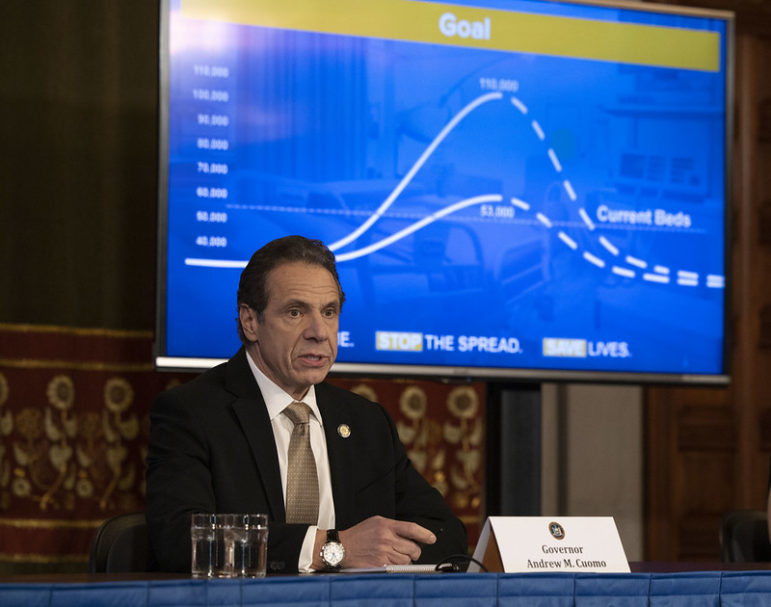
Mike Groll/Office of Governor Andrew M. Cuomo
Governor Andrew M. Cuomo provides a coronavirus update during a briefing in the Red Room at the state Capitol in Albany.
Monday, March 23, 11:50 a.m.
New York State now has 20,000 known cases of the novel coronavirus, including 5,000 cases diagnosed in the past day, Gov. Cuomo said at a late-morning briefing on Monday.
“That is obviously a significant increase. The trajectory is going up. The wave is still going up,” Cuomo said. “You see it spreading across the state as it has across the nation and I think it will continue every day.”
Flanked by former aides like Bill Mulrow who have rejoined the governor to help him navigate the crisis and daughter Cara Kennedy-Cuomo, who will work for $1 a year at her father’s side during the emergency, Cuomo said New York was now conducting 16,000 tests a day—a rate that compares favorably with the most aggressive testers internationally, he said, and one that would certainly lead to higher case counts. New York has tested 78,000 people for COVID-19 so far—25 percent of the tests conducted nationally.
Of those testing positive, 13 percent are hospitalized—a rate that has dropped since last week, when it approached 20 percent. Among the COVID sufferers in the hospital, 24 percent are in intensive care.
The governor said the state had obtained supplies including 430,000 surgical masks; 136,000 pairs of gloves; and 169,000 of the precious N-95 masks and would begin distributing them around the state. He called on the federal government to assert its power to order manufacturers to make more. “You cannot continue to do these supplies on an ad hoc basis,” he said.
On the first full day on which the economy had largely shut down on his order, Cuomo argued it was time to begin planning for how to bring some of the suspended industries and remote-working employees back online. “We have to start to plan the pivot back to economic functionality. You can’t stop the economy forever. We have to start to think about. Does everyone still stay out of work? Do young people go back to work sooner?”
It might be wise, he said, to only isolate vulnerable people and let everyone else return to work—not just for economic reasons, but also because doing so would limit the number of people interacting with the vulnerable at home.
Lessons would need to be learned from the COVID-19 crisis because the state was unprepared for a public-health crisis of this magnitude, Cuomo indicated.
However, Cuomo insisted, “I have no second thoughts on actions that I have taken. I would take those same actions today.”
City Hall says at least 1,800 people with Coronavirus are hospitalized in the city, with 450 in intensive care.
The governor said efforts to expand hospital capacity—all facilities are being required to expand capacity by 50 percent and asked to boost it by 100 percent—continue, but insisted that there is no immediate shortage of masks in New York State now.
Statistics released by the city gave early hints at patterns of infection and fatality. Men have been overrepresented among infections and even more so among deaths. Bronx residents have been a significantly larger share of deaths than of cases.
City data on cases and deaths as of March 22:
Age group Cases Age group Deaths 0 to 4 0.42% 0 to 17 0.00% 5 to 17 2.33% 18 to 44 0.00% 18 to 49 54.95% 45 to 64 26.98% 50 to 64 23.79% 65 to 74 19.05% 65 and over 18.52% 75 and over 53.97% Sex Cases Deaths Female 40.94% 31.75% Male 59.06% 68.25% Borough Cases Deaths Bronx 13.21% 22.22% Brooklyn 30.63% 22.22% Manhattan 22.97% 15.87% Queens 27.79% 33.33% Staten Island 5.39% 6.35%
Comptroller Sees Billions in Revenue Loss to City
Monday, March 23, 8:34 a.m.
City Comptroller Scott Stringer on Monday released an analysis of the fiscal impact of COVID-19 and the efforts to contain it.
The report outlines two potential scenarios: one in which the virus and related measures are gone by May, and another in which the measures remain in place until June or July.
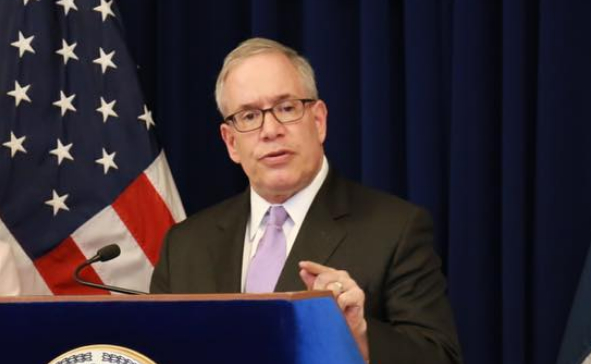
Office of the Comptroller
Stringer
The shorter scenario affects primarily hotels, restaurants and retail and costs the city $4.8 billon in revenue between this fiscal year and next. The $3.5 billion in losses next year (which begins July 1) represent a 5.4 percent decline.
Under either scenario, Stringer “forecasts a very sharp decline in specific sectors from March through the end of June, particularly in hotels, restaurants, retail and the cultural sector, as earnings collapse and unemployment soars.”
The budget shortfalls in this fiscal year could be covered with the predicted surplus, but since that surplus was supposed to be applied to close next year’s budget gap, doing that would just create a larger hole to fill down the road.
City Issues Guidance for Shutdown on Nonessential NY
Friday, March 20, 11:15 p.m.
Mayor de Blasio on Friday evening issued a new executive order laying out how the city would impose the shutdown on nonessential services that Governor Cuomo has ordered effective Sunday evening.
City Hall said the following rules would be imposed:
- No non-essential gatherings; any concentration of people outside their home must be limited to workers providing essential services
- Practice social distancing in public (6 feet or more)
- Individuals should limit outdoor recreational activities to non-contact.
- Limit use of public transportation to only when absolutely necessary.
- Sick individuals should not leave home except to receive medical care.
- No non-essential gatherings; any concentration of people outside their home must be limited to workers providing essential services
- Practice social distancing in public (6 feet or more)
Additional rules are in place for those aged 70 and over.
City Hall also updated the case count to 5,683 positive cases of COVID-19 and 43 fatalities as of 6 p.m.—532 more cases and 14 more deaths than had been reported at 10 a.m..
NYC is ‘Epicenter’ of U.S. Epidemic, Mayor Says
Friday, March 20, 6:26 p.m.
A third of known Coronavirus cases in the United States, and two-thirds of the positive viral tests in New York State, are in the five boroughs, Mayor de Blasio said Friday.
“We are now the epicenter of this crisis,” the mayor said, as the case count hit 5,151 and the death toll reached 29. The borough breakdown was:
- The Bronx: 667
- Brooklyn: 1,518
- Manhattan: 1,314
- Queens: 1,406
- Staten Island: 242
NYPD Commissioner Dermot Shea said crime and 911 calls had dropped in the past week and that the number of officers calling in sick was climbing but had not reached a level of concern. Reacting to calls for reduced enforcement of low-level crimes, Shea indicated no change in policy was under consideration.
“I’m very comfortable with where we are right now in terms of policing in this city,” he said. “We have no intention of strategically cutting enforcement because of this Coronavirus.”
Gov Reveals Who is ‘Essential’ & Exempt from Stay-Home Order
Friday, March 20, 4:55 p.m.
Gov. Cuomo’s office on Friday afternoon released a list of the “essential business” exempt from the PAUSE executive order. Here they are, as categorized by the governor’s office:
1. Essential Health Care Operations, Including:
- research and laboratory services
- hospitals
- walk-in-care health facilities
- emergency veterinary and livestock services
- elder care
- medical wholesale and distribution
- home health care workers or aides for the elderly
- doctor and emergency dental
- nursing homes, or residential health care facilities or congregate care facilities
- medical supplies and equipment manufacturers and providers
2. Essential Infrastructure, Including:
- utilities including power generation, fuel supply and transmission
- public water and wastewater
- telecommunications and data centers
- airports/airlines
- transportation infrastructure such as bus, rail, or for-hire vehicles, garages
- hotels, and places of accommodation
3. Essential Manufacturing, Including:
- food processing, manufacturing agents, including all foods and beverages
- chemicals
- medical equipment/instruments
- pharmaceuticals
- sanitary products
- telecommunications
- microelectronics/semi-conductor
- agriculture/farms
- household paper products
4. Essential Retail, Including:
- grocery stores including all food and beverage stores
- pharmacies
- convenience stores
- farmer’s markets
- gas stations
- restaurants/bars (but only for take-out/delivery)
- hardware and building material stores
5. Essential Services, Including:
- trash and recycling collection, processing and disposal
- mail and shipping services
- laundromats
- building cleaning and maintenance
- child care services
- auto repair
- warehouse/distribution and fulfillment
- funeral homes, crematoriums and cemeteries
- storage for essential businesses
- animal shelters
6. News Media
7. Financial Institutions, Including:
- banks
- insurance
- payroll
- accounting
- services related to financial markets
8. Providers of Basic Necessities to Economically Disadvantaged Populations, Including:
- homeless shelters and congregate care facilities
- food banks
- human services providers whose function includes the direct care of patients in state-licensed or funded voluntary programs; the care, protection, custody and oversight of individuals both in the community and in state-licensed residential facilities; those operating community shelters and other critical human services agencies providing direct care or support
9. Construction, Including:
- skilled trades such as electricians, plumbers
- other related construction firms and professionals for essential infrastructure or for emergency repair and safety purposes
10. Defense
- defense and national security-related operations supporting the U.S. Government or a contractor to the US government
11. Essential Services Necessary to Maintain the Safety, Sanitation and Essential Operations of Residences or Other Essential Businesses, Including:
- law enforcement
- fire prevention and response
- building code enforcement
- security
- emergency management and response
- building cleaners or janitors
- general maintenance whether employed by the entity directly or a vendor
- automotive repair
- disinfection
12. Vendors that Provide Essential Services or Products, Including Logistics and Technology Support, Child Care and Services:
- logistics
- technology support for online services
- child care programs and services
- government owned or leased buildings
- essential government services
Suit Filed to Free 116 From Rikers, Citing COVID Threat
Friday, March 20, 11:11 a.m.
The Legal Aid Society filed suit on Friday to try to force the removal of 116 medically vulnerable people from Rikers Island. It’s not the first such legal move since the Coronavirus outbreak began, but it appears to affect more detainees than any previous effort.
On Thursday, Mayor de Blasio said the city had identified 40 inmates on Rikers who ought to be released, and indicated the review of cases was ongoing. Advocates have called for a far larger number of releases. On Wednesday, Public Advocate Jumaane Williams and City Councilmember Brad Lander said 600 people in city jails were over 50 years old and suffered from some chronic health condition that elevates their risk of dying from COVID-19.
The Legal Aid petition, which was filed in state court argues that continuing to hold those 116 people “constitutes deliberate indifference to the risk of serious medical harm in violation of the Fourteenth Amendment and state constitutional right to due process.” It notes that more than 9,000 people have died from the virus worldwide and the New York City has thousands of cases. “These numbers are growing rapidly every day,” the suit reads. “There is no vaccine or cure for COVID-19. No one is immune.”
One Department of Correction official died of the disease and a number of Correction Officers have been diagnosed with it. At least one inmate has tested positive.
The population on Rikers—including those who might be considered vulnerable to serious consequences from COVID-19—includes people held on various grounds. Most are awaiting trial, and either have been unable to post bail or jailed without hope of bail (“remanded”). Some are there for technical parole violations. Others are awaiting transfer to state prison, or serving sentences of less than a year. At least 200 of the vulnerable patients are held on federal remands. The diversity of reasons for detention complicate the process of health-related releases because a number of actors—the governor, the mayor, district attorneys, judges and federal officials—could be involved in deciding who should be removed.
Among the detainees covered by the Legal Aid suit are a person who is 64 years old and suffers from asthma and chronic obstructive pulmonary disease, a 54-year-old with a heart condition, a 19-year-old with asthma and a 76-year-old.




